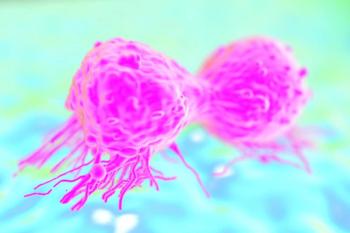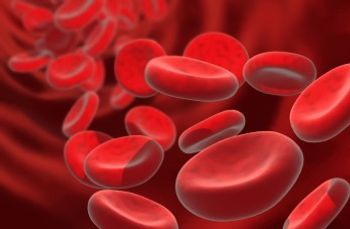
Olutasidenib Results in Long-Lasting Responses for IDH1+ Relapsed/Refractory AML
Patients with IDH1-mutant relapsed/refractory acute myeloid leukemia achieved a notable complete response rate following treatment with olutasidenib.
Durable long-lasting response were observed following treatment with single-agent olutasidenib (Rezlidhia) in patients with IDH1-mutant relapsed/refractory acute myeloid leukemia (AML), according to data from the phase 1/2 Study 2102-HEM-101 (NCT02719574) that read out at the 2022 American Society of Hematology (ASH) Annual Meeting.
The agent elicited a CR rate of 32% (n = 47; 95% CI, 24.5%-40.2%) and a CR with partial hematologic recovery (CRh) rate of 3% (n = 4), with median times to response of 2.8 months (range, 0.9-7.4) and not assessed, respectively, for a combined CR+CRh rate of 35% (n = 51; 95% CI, 27.0%-43.0%) and a combined median time to response of 1.9 months (range, 0.9-5.6). Additionally, 10% of patients (n = 15) had a CR with incomplete recovery (CRi), 2% (n = 3) had a partial response, 1% (n = 2) had a morphologic leukemia-free state, and 35% (n = 52) did not respond.
“Olutasidenib induced durable remissions and transfusion independence with a well-characterized and manageable adverse effect [AE] profile,” lead study author, Jorge Cortes, MD, of the Georgia Cancer Center of Augusta University, and colleagues wrote in a poster of the data.
Between 7% and 14% of patients with AML have IDH1 mutations. Inhibiting IDH1 in tumor cells can restore normal cellular differentiation and provide therapeutic benefit in cancers that express IDH1.
Olutasidenib is a potent, selective, oral, small-molecule IDH1 inhibitor that previously demonstrated clinical activity and tolerable safety in patients with IDH1-mutant AML in the phase 1 portion of the phase 1/2 trial.
This trial enrolled 153 patients with IDH1-mutant, relapsed/refractory AML, all of whom received at least 1 dose of olutasidenib and were included in the safety population. The efficacy evaluable population included 147 patients with centrally confirmed IDH1 mutations who received the first dose of olutasidenib at least 6 months before the data cutoff date of June 18, 2021, and excluded 6 patients without centrally confirmed IDH1 mutations.
In the phase 2 cohort of this open-label, multicenter trial, patients received olutasidenib at 150 mg twice daily in continuous 28-day cycles.
The primary end point of this trial was CR+CRh rate, per modified 2003 International Working Group criteria. Key secondary end points were overall response rate (ORR), duration of CR+CRh, duration of response (DOR), transfusion independence rate including red blood cells (RBCs) and/or platelets, and overall survival (OS).
Of the efficacy-evaluable population, 50% (n = 74) were men, with a median age of 71.0 years (range, 32-87). In total, 66% (n = 97) had primary de novo AML and 34% (n = 50) had secondary AML. Additionally, 4% (n = 6), 73% (n = 107), 17% (n = 25), and 6% (n = 9) had favorable, intermediate, poor, and unknown cytogenetics, respectively. A total of 35% (n = 51) of patients had refractory disease and 65% (n = 96) had relapsed disease, with a median of 2.0 prior treatments (range, 1-7). Moreover, 97% (n = 143) had received prior induction therapy, and 12% (n = 17) had received prior hematopoietic stem cell transplantation (HSCT).
At data cutoff, 14% of patients (n = 21) were still receiving treatment. Primary reasons for treatment discontinuation included disease progression (41%; n = 62), AEs (17%; n = 26), HSCT (10%; n = 15), death (9%; n = 14), investigator decision (5%; n = 7), permanent withdrawal of consent (3%; n = 5), and patient decision, lack of response, and patient non-compliance (1%; n = 1 each).
Additional results showed that the ORR was 48% (n = 71), with a median time to response of 1.9 months (range, 0.9-10.2).
The median duration of CR+CRh was 25.9 months (95% CI, 13.5-not evaluable [NE]), and the median duration of CR was 28.1 months (95% CI, 13.8-NE). The median DOR in the entire efficacy evaluable population was 11.7 months (95% CI, 6.9-25.9).
In total, 12 patients had received prior venetoclax (Venclexta) and experienced response rates similar to those of the entire efficacy-evaluable population. Specifically, the CR+CRh rate was 33% (n = 4; 95% CI, 9.9%-65.1%) and the CR rate was 25% (n = 3; 95% CI, 5.5%-57.2%).
In the overall population, the median OS was 11.6 months (95% CI, 8.9-15.5). Specifically, the median OS was not reached (NR; 95% CI, 22.8-NR), 13.7 months (95% CI, 6.0-NR), and 4.0 months (95% CI, 3.2-5.8) in the CR+CRh responders, other responders, and non-responders, respectively. The estimated 18-month survival rate of patients with a CR+CRh was 78%.
Across all response groups, among 86 patients who were RBC and/or platelet transfusion dependent at baseline, 34% (n = 29) achieved 56-day transfusion independence. The investigators observed higher transfusion independence rates in baseline transfusion-dependent patients who achieved CR+CRh than in other responders.
A total of 11% of patients (n = 16) were eligible for HSCT following olutasidenib treatment, 1 of whom discontinued olutasidenib because of an AE prior to HSCT. Of the 15 patients who discontinued olutasidenib for HSCT, 11, 3, and 1 had achieved CR+CRh, CRi, and stable disease, respectively.
Regarding safety, 73% of patients (n = 111) experienced any-grade AE, and 39% (n = 59) experienced a grade 3 or 4 AE. Specifically, the most common treatment-related AEs included nausea (any grade, 23%; grade 3/4, 0%), differentiation syndrome (any grade, 14%; grade 3/4, 9%), leukocytosis (any grade, 13%; grade 3/4, 5%), alanine aminotransaminase increases (any grade, 8%; grade 3/4, 3%), constipation (any grade, 8%; grade 3/4, 0%), fatigue (any grade, 7%; grade 3/4, 1%), vomiting (any grade, 7%; grade 3/4, 0%), anemia (any grade, 6%; grade 3/4, 5%), aspartate aminotransferase increases (any grade, 6%; grade 3/4, 2%), thrombocytopenia (any grade, 5%; grade 3/4, 4%), neutropenia (any grade, 5%; grade 3/4, 5%), gamma-glutamyltransferase increases (any grade, 5%; grade 3/4, 5%), and hepatic enzyme increases (any grade, 4%; grade 3/4, 3%).
One fatal case of differentiation syndrome occurred; however, most cases were resolved with treatment interruption, dexamethasone, and/or supportive care. Hepatic AEs were manageable with concomitant medications and dose modifications. No QTc prolongation effects led to treatment discontinuation.
In total, 31% of patients (n = 48) experienced treatment-emergent AEs leading to treatment discontinuation, including disease progression (14%), differentiation syndrome, febrile neutropenia, and pneumonia (2% each).
A total of 48 deaths (31%) were reported, with most related to AML progression or complications. The most common AEs leading to death were disease progression (14%), pneumonia (2%), and cerebral hemorrhage, sepsis, pneumonia fungal, respiratory failure, and other (1% each).
“The observed activity is clinically meaningful and represents a therapeutic advance in the treatment of this molecularly defined, poor-prognosis patient population with relapsed/refractory IDH1-mutant AML,” the study authors concluded.
Reference
Cortes J, Fenaux P, Yee, K, et al. Olutasidenib (FT-2102) induces durable complete remissions in patients with relapsed/refractory mIDH1 acute myeloid leukemia. Results from a planned interim analysis of a phase 2 pivotal clinical trial. Blood. 2022;140(suppl 1):6193-6196. doi:10.1182/blood-2022-167330
Newsletter
Stay up to date on recent advances in the multidisciplinary approach to cancer.

















































































